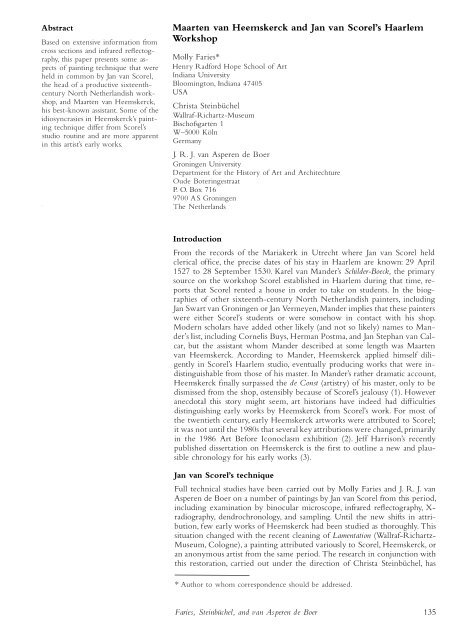Historical Painting Techniques, Materials, and Studio Practice
Create successful ePaper yourself
Turn your PDF publications into a flip-book with our unique Google optimized e-Paper software.
Abstract<br />
Based on extensive information from<br />
cross sections <strong>and</strong> infrared reflectography,<br />
this paper presents some aspects<br />
of painting technique that were<br />
held in common by Jan van Scorel,<br />
the head of a productive sixteenthcentury<br />
North Netherl<strong>and</strong>ish workshop,<br />
<strong>and</strong> Maarten van Heemskerck,<br />
his best-known assistant. Some of the<br />
idiosyncrasies in Heemskerck's painting<br />
technique differ from Scorel's<br />
studio routine <strong>and</strong> are more apparent<br />
in this artist's early works.<br />
Maarten van Heemskerck <strong>and</strong> Jan van Scorel's Haarlem<br />
Workshop<br />
Molly Faries*<br />
Henry Radford Hope School of Art<br />
Indiana University<br />
Bloomington, Indiana 47405<br />
USA<br />
Christa Steinbuchel<br />
Wallraf-Richartz-Museum<br />
Bischofsgarten 1<br />
W-5000 Kaln<br />
Germany<br />
J. R. J. van Asperen de Boer<br />
Groningen University<br />
Department for the History of Art <strong>and</strong> Architechture<br />
Oude Boteringestraat<br />
p. 0. Box 716<br />
9700 AS Groningen<br />
The Netherl<strong>and</strong>s<br />
Introduction<br />
From the records of the Mariakerk in Utrecht where Jan van Scorel held<br />
clerical office, the precise dates of his stay in Haarlem are known: 29 April<br />
1527 to 28 September 1530. Karel van M<strong>and</strong>er's Schilder-Boeck, the primary<br />
source on the workshop Scorel established in Haarlem during that time, reports<br />
that Scorel rented a house in order to take on students. In the biographies<br />
of other sixteenth-century North Netherl<strong>and</strong>ish painters, including<br />
Jan Swart van Groningen or Jan Vermeyen, M<strong>and</strong>er implies that these painters<br />
were either Scorel's students or were somehow in contact with his shop.<br />
Modern scholars have added other likely (<strong>and</strong> not so likely) names to M<strong>and</strong>er's<br />
list, including Comelis Buys, Herman Postma, <strong>and</strong> Jan Stephan van Calcar,<br />
but the assistant whom M<strong>and</strong>er described at some length was Maarten<br />
van Heemskerck. According to M<strong>and</strong>er, Heemskerck applied himself diligently<br />
in Scorel's Haarlem studio, eventually producing works that were indistinguishable<br />
from those of his master. In M<strong>and</strong>er's rather dramatic account,<br />
Heemskerck finally surpassed the de Const (artistry) of his master, only to be<br />
dismissed from the shop, ostensibly because of Scorel's jealousy (1). However<br />
anecdotal this story might seem, art historians have indeed had difficulties<br />
distinguishing early works by Heemskerck from Scorel's work. For most of<br />
the twentieth century, early Heemskerck artworks were attributed to Scorel;<br />
it was not until the 1980s that several key attributions were changed, primarily<br />
in the 1986 Art Before Iconoclasm exhibition (2). Jeff Harrison's recently<br />
published dissertation on Heemskerck is the first to outline a new <strong>and</strong> plausible<br />
chronology for his early works (3).<br />
Jan van Scorel's technique<br />
Full technical studies have been carried out by Molly Faries <strong>and</strong> J. R. J. van<br />
Asperen de Boer on a number of paintings by Jan van Scorel from this period,<br />
including examination by binocular microscope, infrared reflectography, X<br />
radiography, dendrochronology, <strong>and</strong> sampling. Until the new shifts in attribution,<br />
few early works of Heemskerck had been studied as thoroughly. This<br />
situation changed with the recent cleaning of Lamentation (Wallraf-Richartz<br />
Museum, Cologne), a painting attributed variously to Scorel, Heemskerck, or<br />
an anonymous artist from the same period. The research in conjunction with<br />
this restoration, carried out under the direction of Christa Steinbuchel, has<br />
* Author to whom correspondence should be addressed.<br />
Faries, Steinbuchel, <strong>and</strong> van Asperen de Boer 135


